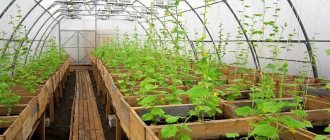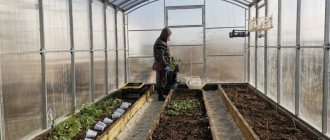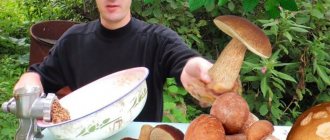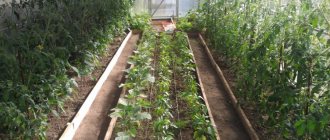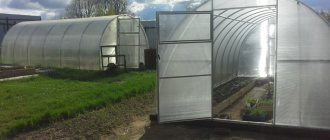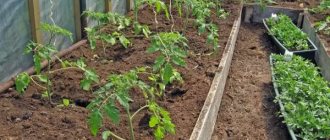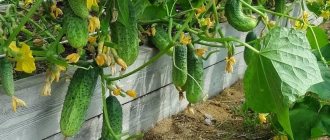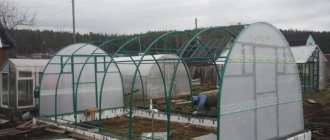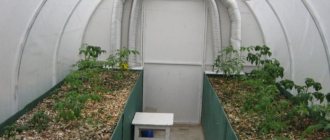In addition to the popular tomatoes and cucumbers, there are other crops that feel ideal in a polycarbonate greenhouse. And if you want to diversify your table or organize a mini-business, then you can combine several very different crops in one greenhouse. This is possible: varieties of vegetables, herbs and berries can “get along” in the same space, the main thing is that they have similar preferences for the level of humidity, light and soil type.
Here are a few ideas for those who are wondering what else to plant in their collapsible greenhouse besides tomatoes and cucumbers.
Where to begin
You should start running a business by developing a business plan. It includes the following sections:
- assessment of the market situation, analysis of competitors' activities. It is necessary to find out what exactly other producers grow, in what quantities, where they sell the finished products;
- choosing a product to grow. After this, you can determine the specific area for crops, type of fertilizing, method of care, etc.;
- choosing the type of greenhouse;
- determining methods of marketing finished products;
- calculation of investments and income. This will allow you to determine how much money you need to invest and how long it will take for the expenses to pay off;
- searching for sources of additional funding.
Attention! To start running a greenhouse business, you need at least minimal experience in growing plants. Without this, it is impossible to earn income from running your own business.
Greenhouse business is one of the forms of earning money
The main disadvantage of the greenhouse business
The very first thing that can bring any greenhouse project into the red is heating the greenhouse. Heating a brick house and a polycarbonate greenhouse is not the same thing. For example, heating a house of 50 square meters. m costs 2500 rubles/month in winter, then a thin greenhouse of the same area will cost 5–10 times more. Even in the southern regions, farmers do not keep greenhouses all year round, but open the season only in February - March. A similar arrangement goes with greenhouse lighting. Dim light like in an apartment definitely won’t work. Plants in the cold season need the same daylight hours as they receive in the warm season. The light must be bright, and this means very high energy costs. What can I say, even growing tomatoes on a windowsill requires additional light. Someone may object: “Well, we will sell the product at a high price, look how much a tomato costs in February.” Prices that can be observed in grocery chains should not be a guide. Vegetables and herbs are sold in bulk at almost half the price shown on the shop window. This happens because retail has its own costs associated with logistics, markdowns, taxes, salesperson salaries, and so on. Do you want to trade without intermediaries, and in a wide variety of goods? Now this is not a problem at all, you can place your ad on Avito. Find out how to get a stable income from ads, what is better to sell on the Internet and what is the best way to make money.
Initial capital
To organize a business, you need start-up capital. Its amount depends on several factors:
- the amount of available funds;
- type of greenhouse, crop;
- scale of production.
Before investing, you need to calculate the amount of expected profit and the time when the contributions will pay off. It's best to start with small financial investments. Gradually, the business can be expanded if it brings good, stable income.
The greenhouse business can be expanded if it brings good, stable income
How to solve the problem of snakes on the site
With moles the situation is unpleasant, but not dangerous; snakes are a different matter. Meeting a viper in a greenhouse is not a sight for the faint of heart. And even if the reptile is not poisonous at all, but just a harmless snake, who will figure it out - it’s scary and that’s all!
It is worth knowing that the problem with snakes occurs today in all regions except the Far North. Humans occupy the habitat of these animals and therefore snakes become “frequent guests” in dachas and suburban areas. And again EcoSniper snake repellents will come to the rescue. As with moles, reptile devices create a wave of vibration, forcing the reptiles to move away. There is no harm to people, pets or even poisonous reptiles - EcoSniper snake repellents carefully expel pests without causing them physical harm.
When to open a business
The optimal time to start a business is before the start of the summer season. The task of the business manager is to get the harvest before the fruits of the owners of private gardens ripen. This will allow the cost of products to be higher, since demand will be greater. Therefore, this is what will help you make a significant profit.
Attention! It is best to start a business with small crops. This will make it possible to decide on the type of crop to be grown, the market for the future and will give a real idea of investments and the amount of income.
Business in greenhouses will allow you to have a harvest all year round
How to grow a full-fledged crop in a greenhouse
In order to get the maximum yield, you need to combine crops and choose the right sowing time, plus take care of proper soil moisture and nutrition. Since water consumption is quite high due to the temperature inside, many gardeners successfully switch to drip irrigation. In addition, plants growing in special conditions prefer only warm water rather than cold water coming directly from a pipe. If you want to plant plants in a greenhouse, you will have to monitor the water temperature and take it from special tanks that warm up under the sun during the day.
If you plant tomatoes and tomatoes at the same time, dividing them in beds so that they do not directly touch each other, it is important to remember that they prefer different humidity regimes. Cucumbers consume moisture in much greater quantities than tomatoes, so watering will be different. Fertilizers also need to be applied to the soil in different ways. Cucumbers love regular cow or bird droppings diluted to an optimal consistency in water, and tomatoes grow well on fertilizers based on phosphorus, potassium and some other minerals.
Required Documentation
Legal registration of greenhouse business – legalization of production. To register your own business, you need to decide on the type of business object:
- individual entrepreneurship. This form is recommended if large production volumes and a wide distribution line are planned. In this case, a certificate of conformity is required, which is given to the individual entrepreneur;
- peasant farming. This form is chosen if you plan to do business with other participants. Polyus Peasant Farm – the opportunity to participate in government programs;
- personal subsidiary plot. Suitable for owners and tenants of plots up to 2 hectares.
Each form will require a specific package of documents, which are presented on the official website of the tax office. After preparing the kit, it must be taken to the MFC. If there are no complaints about the documents, after a certain period of time you can pick up the finished certificate. The exact deadline will be announced at the MFC after the package is accepted.
Preparatory work
Scheme of drip irrigation in a greenhouse.
As mentioned above, to plant vegetables or flowers in a greenhouse, the first step is to select an area and build the greenhouse itself. The site must be open and sufficient in area. The greenhouse can be made to almost any size, the optimal width should be no more than 5 m, but there are no restrictions on the length. The site must be well insulated, since sunlight is necessary for plant growth and photosynthesis. Once the area has been selected, you will need to build a foundation.
Polycarbonate greenhouses are currently becoming increasingly popular. This building material has many advantages. Firstly, it is quite easy to install, and secondly, it has good thermal insulation properties, which means it does not require powerful heating in the greenhouse. Polycarbonate allows the sun's rays to pass through and dissipate them well. Fourthly, unlike simple glass, it is an impact-resistant material, in addition, it is flexible. Its biggest advantage is that it is financially accessible. To build such a greenhouse, it is advisable to organize a strip or monolithic foundation; the first option is simpler and cheaper.
Return to contents
Advantages and disadvantages
Greenhouse business has the following advantages:
- growing organic products that can be used not only for sale, but also for food;
- the ability to grow fresh food throughout the year;
- obtaining vegetables, fruits, berries 10-30 days earlier than when they are grown in open ground;
- Some forms of farming have government support, which allows them to reduce their own expenses.
Greenhouse business has many positive qualities
Flaws:
- large capital investments;
- reduction in the cost of production during the season;
- short shelf life of products;
- high cost of utilities - heating, electricity, etc.
Flowers
They are needed always and everywhere, because you want to please your loved ones with beautiful bouquets all year round. In this regard, we conclude that growing flowers, including potted ones, is very profitable - your business will quickly and easily pay for itself.
Decide what plants you want to grow: indoor or garden. Both types have their advantages and disadvantages: garden ones are unpretentious, but once cut, they need to be sold immediately; indoor ones require a lot of attention, but they can be implemented at any time without haste.
You can immediately grow both the first and second ones. But remember that your problems will double. You will also need to think about the delivery method and learn to adapt to the timing, that is, provide products when they are really needed - before the holidays.
Choosing a location for a greenhouse
It is recommended to install greenhouses close to the infrastructure so that there are no problems with connecting communications:
- electricity;
- heating;
- water.
In addition, greenhouses need to be located in a place with convenient transport access, close to sales points, so as not to spend a lot of money on transporting products.
If you plan to build a small structure, you can arrange it next to your dacha or house. The advantages of this greenhouse arrangement:
- no need to buy land or lease it;
- walking distance;
- fast, easy communication.
If you set up a greenhouse on a rented plot, you need to take into account the following risks:
- increase in rental costs;
- Rental refusal during high season.
Such situations usually arise because the land owner wants to take over the tenant's business. It is for this reason that it is better to build greenhouses on your own site.
Arranging your own plot with greenhouses
What to plant next to cucumbers
Cucumbers tend to cling to any object with their antennae. And so that they do not damage neighboring plants, they should be grown on a trellis in a greenhouse.
To cucumbers you can add dill, parsley, basil, fennel, leaf and head lettuce, white cabbage (of course, if there is enough space for it), radish, eggplant (varieties Siberian early ripening 148, Mushroom Picker's Dream), sweet pepper (Giganto Rossa F1 , Ural thick-walled F1, Yellow giant F1, Red giant F1, Orange giant F1, Dutch giant, Queen Elizabeth F1).
But the proximity of tomato, watermelon and sage is undesirable for a cucumber.
Radish growing nearby protects cucumbers from leaf beetles and spider mites
Greenhouse arrangement
Structures are arranged in several ways:
- order a product based on a ready-made or individual project. The second option will cost more, but will allow you to get a greenhouse with the required dimensions, design features, etc.;
- buy the finished product. On the modern market there are greenhouses made of different materials, different shapes, and dimensions. This allows you to choose the appropriate option;
- do it on their own. This is the most budget-friendly way to set up a greenhouse. All you need is to purchase the appropriate materials. The difficulties lie in performing calculations and drawings.
A greenhouse is not real estate. This eliminates the need to obtain permission for its construction.
Improved greenhouse
The following materials are used to construct a greenhouse:
- polypropylene;
- polycarbonate;
- glass.
Polyethylene film is rarely used due to low efficiency.
The frame of the structure is made of wood, metal, and PVC pipes.
The inside of the greenhouse can be improved. To do this, electricity is provided, a heating system is organized, etc. This will allow you to quickly get a rich harvest, since additional lighting and high temperatures accelerate the growth and maturation of plants.
Temperature conditions and other features
If the temperature within the same greenhouse also differs, which happens most often, then the warmest area, which is under the sun for the longest time, is intended for cucumbers, and the bed with lower temperatures is good for tomatoes. Sometimes summer residents additionally separate crops in the greenhouse with light partitions, for example, made of plastic or even ordinary plywood. This will allow you to slightly change the humidity level, creating an optimal regime for each crop.
Often, gardeners plant one crop, but of different types, for example, hot and sweet peppers. But it is undesirable to do this, since due to the almost inevitable cross-pollination, the taste will change. Sweet varieties will develop a bitter taste, while bitter varieties, on the contrary, will lose their rich, pungent flavor.
A classic set for a gardener (this is just one of the options): cucumbers, squash, zucchini of any kind, watermelons, melon, pumpkins. It is advisable to place cucumbers in the central part, and the rest of the plants around the perimeter. To repel pests, it is advisable to plant several bushes of low-growing marigolds in different parts of the greenhouse.
Types of greenhouses
There are several types of greenhouses that can be used for doing business.
DIY budget greenhouse
A small structure that is usually erected next to a house or on a summer cottage. It is suitable for people with a limited budget who want to try their hand at running a greenhouse business.
Such greenhouses are made deep into the soil, which ensures their stability even in strong gusts of wind.
Budget greenhouse
Greenhouse
Seasonal greenhouse
A structure that is installed only for the summer season. After its completion, the structure is dismantled and stored for storage.
The greenhouse is installed in March. To do this, the snow on the ground under the structure is cleared. To prevent the cold from the frozen soil from penetrating inside the structure, sheets of roofing material are placed on the area under the greenhouse. In addition, you can put rotted straw with mullein under the beds. This will help the soil to thaw faster and saturate the soil with nutrients for better growth and development of crops.
For seasonal greenhouses, the heating system does not need to be equipped. However, it is impossible to do without additional lighting and water supply.
Seasonal greenhouse
Year-round greenhouse
A capital structure that can be used not only during the summer season, but throughout the year. This allows you to receive stable profits without interruption. Such a structure is suitable for people who are ready to make significant investments in running a business. They will pay for themselves in about 2 seasons, provided that business is handled correctly.
To use the greenhouse throughout the year, it is necessary to equip the building with the following systems:
- heating;
- lighting;
- water supply
Year-round greenhouse
Strawberry
Of all the berries, this is the most popular. It is worth noting that even in the summer, during the season, it is not cheap, but in winter and spring it will be a pleasure to sell it, because it will bring you a decent profit. Farmers say that all costs are recouped after the first harvest.
However, many of those who do this advise hiring people to care for the strawberries. This applies to people who have a large greenhouse.
Lighting is very important for this berry: you should organize it as natural as possible. This no longer concerns the intensity of the lamps, but the cycle of day and night. In other words, around 10 o’clock it’s light, the rest of the time it’s dark.
Regular watering is required. And here you will also need help. And the disadvantages include the fact that the organization to which you will supply the crop will throw away a decent part, evaluating it as defective.
What's the best thing to grow?
There are several crops that are profitable to grow in a greenhouse for sale.
Seedling
This is one of the most common ways to run a greenhouse business. The popularity of growing seedlings is explained by the possibility of generating large income. Typically, businessmen grow vegetable seedlings:
- cucumbers;
- tomato;
- cabbage, etc.
Seedlings of berries and flowers are also in demand.
Seedlings are one of the most common ways to run a greenhouse business.
Seedlings are actively purchased in the spring for growing crops in gardens and summer cottages.
You can sell seedlings not only through the market. They also sell crops online.
A seasonal greenhouse is sufficient for growing seedlings. In this case, there is no need to equip a year-round greenhouse, since sales are carried out mainly in the spring. In one season, you can earn about 700,000 rubles in this way.
Video - Growing seedlings in a greenhouse, what beginners need to know
Vegetables
It is beneficial to grow the following types of vegetables in a greenhouse:
- potato;
- cabbage;
- tomatoes;
- cucumbers;
- radish.
Vegetables have a long shelf life
They are characterized by a long shelf life, which allows them to be sold for some time without fear of rotting.
Other benefits of growing vegetables:
- high demand throughout the year;
- wide choice of implementation methods;
- rapid ripening;
- the possibility of obtaining a rich harvest with proper plant care.
Vegetables can be sold not only in your region, but also delivered to other cities. This expands the market for products and provides the opportunity to receive additional income.
Video - How to become a millionaire by growing vegetables in greenhouses
Flowers
Growing flowers is a profitable but troublesome business. Flaws:
- plants require special care;
- flowers have a short shelf life;
- if the temperature regime and irrigation rules are not observed, the flowers lose their presentation;
- big competition.
Growing flowers in a greenhouse is a profitable business
If you manage to get a rich harvest of good quality flowers and find a market, then the business will be able to generate income of up to 4,000,000 rubles a year. The main thing is to have time to grow the crops by the beginning of March and collect the second harvest by the May holidays.
You can also grow indoor plants. They will generate profit all year and provide additional income for such holidays as Valentine's Day, March 8, Knowledge Day, etc.
Video - Construction of a greenhouse for growing flowers
Berries
The greatest income can be obtained by growing strawberries in a greenhouse. This berry produces a rich harvest throughout the year if you create suitable conditions for it. Benefits of growing strawberries:
- high demand at any time of the year;
- low competition;
- Possibility of sale at a high price.
The greatest income can be obtained by growing strawberries in a greenhouse
Flaws:
- short shelf life;
- It is necessary to create special conditions not only for growing, but also for transporting fruits.
Video - Greenhouse for strawberries
Greenery
Greens can be grown in a greenhouse all year round. Other benefits:
- rapid plant growth;
- rich yield;
- ease of care;
- no large capital investments required;
- the ability to grow several types of crops in one greenhouse.
Greens can be grown in a greenhouse all year round
Flaws:
- low price;
- big competition;
- difficult to find a market for.
Video - Greens in a winter greenhouse
Compatibility of fruit and vegetable crops
At the same time you can plant: basil, beans, peas, garlic, zucchini, dill, all types of salads, turnips, parsley, cucumbers and tomatoes, peppers, eggplants, corn, radishes. How to plant correctly in a greenhouse?
Crops grown in greenhouses that
cannot be combined: cabbage and cucumbers, cabbage and tomatoes, beets and tomatoes, tomatoes and carrots, beans and lettuce, beans and onions.
Read more about what can be combined with tomatoes, cucumbers, eggplants and whether it is possible to plant peppers, cucumbers and tomatoes together.
Joint planting of vegetables can be used in spring and summer, and in a heated greenhouse all year round .
This method is not only convenient, but also useful, since it eliminates the possibility of unilateral depletion of the soil. When organizing the internal space, not only the location of the beds, but also the shape of the greenhouse itself is of great importance.
Carbon dioxide is very important for all plants. To supply it, supply systems and a CO₂ generator are specially equipped.
Greenhouses - growing technology:
If the roof in a greenhouse has sloping corners , then it would be more advisable to plant taller plants in the center and low-growing ones at the edges. And if the shape is square , then it will be more convenient to make three long ridges and two convenient passages between them. For round structures, rounded beds around the perimeter and a round bed inside are suitable.
If you adhere to these rules, the yield in the greenhouse will please you.
The optimal width of the bed for planting plants in a greenhouse is no more than 90 centimeters ; if made wider, it will be inconvenient to cultivate the soil and care for the plants. If the greenhouse has hanging racks, the height should not exceed 1.3 meters , which will allow you to easily reach the plants.
Building a greenhouse with your own hands
Installation of polycarbonate.
To build a foundation, you will need to dig a trench along the entire perimeter of the site to a depth above freezing of the soil (about 70 cm). A sand cushion is laid at the bottom of the trench in several layers, each 20-25 cm long. All layers are leveled, compacted and watered. To add rigidity, reinforcement is made using steel rods interlocked with wire. The next step is installing the formwork. Wooden boards are used for it. The height of the formwork above the surface is approximately 20-30 cm. A concrete mixture based on cement, sand, crushed stone and water is poured into the formwork. It is preferable to take a high brand (300-500).
After installing the foundation, the frame is built. It can be made of wood or metal (from pipes). Polycarbonate is attached to the frame. This is done using self-tapping screws with thermal washers. Screws are screwed in at a distance of at least 2 cm from the edge of the slab. The holes for them are larger than the screw head by 2-3 mm, this is important during thermal expansion of the material. Polycarbonate sheets come in sizes 6x2.1 m and 12x2.1 m. The sheets are attached with the protected side facing out.
Return to contents
Beds for growing plants
Polycarbonate fastening diagram.
To plant tomatoes, cucumbers or flowers, you will need to stock up on quality soil. The land must be fertile. You can make beds for plants yourself or purchase ready-made ones. Now many country stores have an assortment of ready-made beds for greenhouses. They consist of sides and galvanized fasteners. The sides are made of plastic polycarbonate. These beds are very durable and can last more than 10 years. They are prefabricated structures. The height of the side of the bed is 20 cm, and the length can be made to any length. Such ready-made beds, depending on the design and color, can be very diverse.
To lay the beds and grow the plants you will need soil. You can buy land, but it will be very expensive. The best option is to dig up soil in abandoned fields, meadows and forest edges. In this case, only the top layer of soil is taken - turf at a depth of no more than 20-25 cm. After this, the soil should ripen. You need to remember that you need to stock up on soil in early spring after the snow has melted. The earth is placed in a basement or other room and tightly covered with opaque material.
They wait a month or two, then cover it with transparent film and put it in a sunny place. As a result, various biochemical processes begin to actively occur in the soil. The temperature can reach 60°C. Maturing the soil is necessary to cleanse it of bacteria, viruses, fungi, helminth eggs and other parasites. After this, the soil is ready for use.
Return to contents
Rules for caring for tomatoes
Planting tomatoes is the easiest thing, but getting a good harvest is more difficult. After planting the seedlings, they are not watered for 10-12 days. After this they are tied up. Tomatoes are formed into 1 stem, leaving about 7-8 flower clusters. You can leave several stepsons or only one lower one. This must be done in the morning. The columns from them are left 2-3 cm high. To prevent the transfer of viral diseases from one plant to another (healthy one), break off the stepsons so that the juice does not get on other tomatoes. This makes a big difference. They pollinate flowers on their own by gently shaking them. After this, water is immediately sprayed. Spraying increases humidity, so the next step is to ventilate the greenhouse.
x
High humidity can reduce the flavor of tomatoes, making them watery and sour. Before the flowering period, it is recommended to water tomatoes at intervals of 5-6 days at the rate of 4-5 liters of water per 1 m². During the flowering period, these figures increase to 10-15 liters. The water temperature is 20-22°C. During fruiting, fertilize 3-4 times. The first one is organized approximately 3 weeks after planting the seedlings. Each subsequent feeding is done after 10 days. For these purposes, superphosphate, nitrophoska, ash and other fertilizers are used. Problems often arise when growing tomatoes.
Very often, plants become fat, that is, they have powerful stems and leaves and bear fruit very poorly. The reason for this is excessive watering and fertilization. To correct the situation, you need not to water the tomatoes for 10 days, increase the temperature in the greenhouse and carry out root feeding with superphosphate (3 tablespoons of fertilizer per 10 liters of water). 1 liter of this solution is poured under each plant. Tomato leaves and flowers may fall off. This indicates dry soil, high temperature and infrequent ventilation of the room.
x
Return to contents
